|
December 2017

Issue Home >>
|

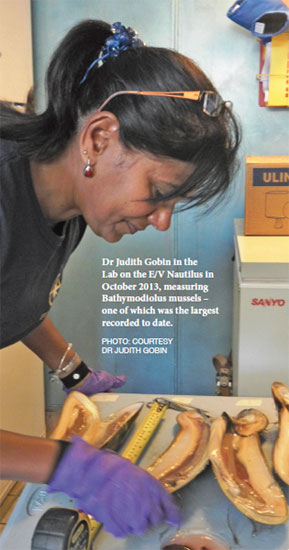 We know very little about life in the deep ocean beds surrounding Trinidad. But recently, a team of six women marine biologists made waves with an October 2017 paper on deep-sea methane vents or cold seeps, and the amazing life they sustain some 4,000 feet under the sea. Among the contributing scientists are Cindy Van Dover and Lisa Levin, two of the world’s top deep-sea biologists from the USA, as well as our very own Dr. Judith Gobin, Senior Lecturer in Marine Biology at The UWI Department of Life Sciences in St. Augustine, Trinidad. Dr Gobin is a major contributor to the knowledge of marine biodiversity in T&T seas due to her life’s work studying the animals that live in the coastal seabed’s soft sediments and rocky areas. We know very little about life in the deep ocean beds surrounding Trinidad. But recently, a team of six women marine biologists made waves with an October 2017 paper on deep-sea methane vents or cold seeps, and the amazing life they sustain some 4,000 feet under the sea. Among the contributing scientists are Cindy Van Dover and Lisa Levin, two of the world’s top deep-sea biologists from the USA, as well as our very own Dr. Judith Gobin, Senior Lecturer in Marine Biology at The UWI Department of Life Sciences in St. Augustine, Trinidad. Dr Gobin is a major contributor to the knowledge of marine biodiversity in T&T seas due to her life’s work studying the animals that live in the coastal seabed’s soft sediments and rocky areas.
Scientists sailing aboard the Exploration Vessel Nautilus found 83 deep-sea species, including a purple octopus, living almost a mile deep in sites off Trinidad’s east coast in the El Pilar area, a place earmarked for oil and gas exploration.
“These communities are absolutely amazing: hundreds of thousands of eight-inch deep-sea mussels, as well as three-foot tubeworms, crabs, shrimp, snails and fishes were found living at the seeps between 1,000 and 1,650 metres depth,” (3,281–5,413 feet depth) said Dr. Diva Amon, a Trinidadian-British postdoctoral deep-sea researcher and colleague of Dr. Gobin, and the lead author of the October 2017 collaborative paper.
Dr. Judith Gobin is the first woman marine biologist from Trinidad and Tobago to have been invited aboard the E/V Nautilus, not just once but twice, in 2013 and in 2014.
The Nautilus is a 64-metre ship on a global mission of marine exploration, and probably the dream vessel for many a marine scientist worldwide. It operates under the Ocean Exploration Trust, and is led by Professor Robert Ballard, veteran ocean explorer and Professor of Oceanography at the University of Rhode Island in the USA.
Prof Ballard is perhaps best known for his discovery of famous shipwrecks, including the Titanic in 1985. He was the person who discovered the remarkable existence of hydrothermal vents in the late 1970s. He founded the Ocean Exploration Trust in 2008, which owns the Nautilus. The Nautilus voyages around the world, exploring new frontiers in marine geology, biology, archaeology and chemistry, while transmitting live audiovisual feeds and data to fellow scientists and ocean life fans.
Dr. Gobin: ‘Nautilus trip is the highlight of my career’
For a Caribbean scientist to be invited aboard the Nautilus is a wonderful opportunity, both for the experience of collaborative discovery and to publicise the work of local researchers. All costs for invited scientists are paid for by the Ocean Exploration Trust.
“It is the highlight of my career so far,” Dr. Gobin said of her 2014 Nautilus experience – that almost did not happen. Official T&T permissions to sail in the area were slow to come, as BHP Billiton had ships earmarked to do seismic tests near there, and there was much red tape and uncertainty about maritime access rights. When permissions did finally come after months of tireless lobbying by Dr. Gobin, the Nautilus had already set sail elsewhere in Caribbean waters, and had just a few days to reach and explore the El Pilar site. Dr. Gobin is very grateful it did happen, and says those few precious days of discovery were “intense,” with scientists working round the clock in shifts.
“I’ve always loved the sea,” said Dr. Gobin in a recent interview for UWI TODAY. Now in her late fifties and sporting a mane of cascading long dark hair, she is the mother of two adult children, Graeme and Jeremy, and radiates youthful energy. She’s married to an orthopaedic surgeon, Dr. Godfrey Araujo, and juggles her family and professional academic life with admirable aplomb.
“As a little girl, I enjoyed amazing family vacation holidays at Mayaro, and was fascinated by the water and sea animals and fish of all kinds. As I got older, swimming, snorkelling and scuba diving became passions I totally enjoyed. Then when I was doing my undergrad degree at UWI, I was fortunate to get a summer job at the Institute of Marine Affairs (IMA). That’s really what shaped my career direction.
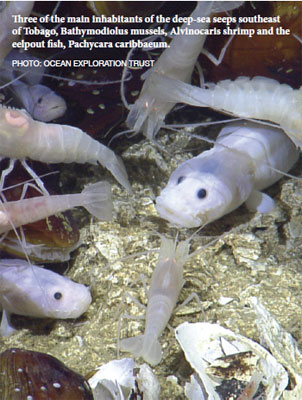 “My very first job after graduating was as a marine research scientist at the IMA for over 15 years. After that, I joined UWI. So I’ve been immersed in research for over 35 years now,” she shares. She is currently a Senior Lecturer in Marine Biology in the Department of Life Sciences at UWI, as well as being the Deputy Dean for Undergraduate Student Affairs in the Faculty of Science and Technology. “My very first job after graduating was as a marine research scientist at the IMA for over 15 years. After that, I joined UWI. So I’ve been immersed in research for over 35 years now,” she shares. She is currently a Senior Lecturer in Marine Biology in the Department of Life Sciences at UWI, as well as being the Deputy Dean for Undergraduate Student Affairs in the Faculty of Science and Technology.
Dr. Gobin began her academic career specialising in Benthic Ecology – the study of organisms that live in the shallow, soft bottom sediments of the coastal sea bed. Benthic animals include worms, crabs, clams, lobsters, sponges and very tiny creatures that live in the mud – perfect creatures for studying impacts of industrial effluents.
Dr. Gobin’s forays into deeper waters began just five years ago, in 2013.
Life in ‘The Van’: high tech tools for live discoveries
Dr. Gobin’s first trip aboard the Nautilus was in 2013 to Grenada and the Kick ’Em Jenny submarine volcano. The following year, Dr. Gobin again landed a spot on the Nautilus, this time as one of the lead scientists in a return voyage to Kick ’Em Jenny as well as to explore methane vent sites in El Pilar off Trinidad’s east coast.
The Nautilus uses remotely operated vessels (ROVs) to explore, because at great depths of over a mile deep, your lungs would totally collapse with the massive water pressure, killing you instantly.
Technology has revolutionized deep-sea explorations, especially the use of deep-diving drones, first used in the 1980s with technology funded by the US Navy. Now, instead of lonely, potentially lethal human dives, scientists and technicians increasingly use remotely controlled, unmanned diving drones and networked, high-speed satellite communications for instant, friendlier group talks and data sharing.
The E/V Nautilus comes well equipped with a multibeam mapping system, sonar mapping tools Diana and Echo, and two remotely operated exploration vehicles (ROVs), the Hercules and the Argus. The ROV Hercules can dive to 4,000 metres, and has a hi-def camera system, lights, sophisticated instruments, manipulators, and a range of sampling tools. The Argus can dive as deep as 6,000 metres.
The Nautilus also has a SeaTel satellite communications system for live streaming video outreach and scientific communication from ship to shore. The Inner Space Centre at the University of Rhode Island’s Graduate School of Oceanography manages all the video and data streams, while the public can see live footage of exploration on the website www.NautilusLive.com when expeditions are under way.
“It’s all very comfortable,” commented Dr. Gobin. “We all wear khaki trousers, navy Nautilus t-shirts and soft-soled shoes aboard the Nautilus, which can hold over 40 people – 31 scientists and 17 ship’s crew (pilots, cooks, navigators, engineers and others). I can’t remember the last time I had to sleep in a bunk bed in a small room with three other people, but it was easy to adapt to the dorm conditions. The ship has an amazing kitchen which serves tasty meals, coffee and snacks round the clock. In 2014, I was one of three scientists on each shift. All the scientists worked four-hour shifts over a 24-hour period, and were free to spend the rest of their time doing their own work or activities.”
The nerve centre of the ship, for the scientists, she said, is a place affectionately called “The Van” – a huge space at the top of the ship with multiple screens lining the walls, collecting or transmitting various feeds.
“So there is always a team of about 12 people in The Van: two ROV operators, three scientists, two videographers, two communications specialists fielding emails and live online questions, two data loggers and a cartographer who communicates with the ship’s captain,” said Gobin. “It’s all very collaborative and interactive.”
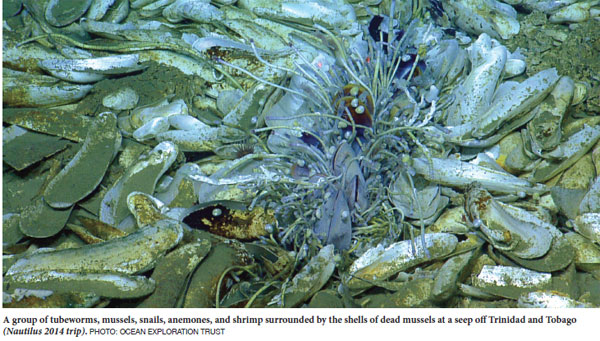 “What was really great was there was no distinction between men and women as to what roles they play on the ship. I noticed, for instance, that the super-precise job of deploying and retrieving the ROVs was being done by women as well as men. And the ratio of men to women is fairly even.” “What was really great was there was no distinction between men and women as to what roles they play on the ship. I noticed, for instance, that the super-precise job of deploying and retrieving the ROVs was being done by women as well as men. And the ratio of men to women is fairly even.”
There’s an international feel, too, as graduate students from the USA, UK, Mexico, Spain and Italy added to the mix for her 2014 Nautilus trip. On every Nautilus voyage, scientists local to the exploration area are invited to take part.
Life at great depths – 4,000 to 5,000 feet down – has evolved remarkable ways to survive in the total absence of sunlight and plant life. And that fascinates Dr. Gobin.
She says: “Deep sea organisms are extremely interesting because they live in super dark, pitch-black places where there is often absolutely no light. They can withstand extremely high water pressures. And there is not a lot of food. Those are extreme conditions for any animal to live in.
“Such deep sea organisms have evolved different ways to exist. Some have huge eyes that can filter even the tiniest speck of light that manages to reach them; and many are blind, because they don’t need to see – their other senses, like detecting motion and sound, are much more developed. Some animals have bioluminescence. It’s a whole different world. And you often find gigantism – the mussels, for example, can grow to very large sizes, and isopods (ancient crustaceans with hard external shells and jointed limbs) can get really quite large. Some of the deep water corals have evolved there for thousands of years.”
Perhaps the most fascinating thing about life forms so deep is that many of them, such as the fauna at El Pilar, find their nourishment from processing methane rather than sunlight. So instead of photosynthesis, there is chemosynthesis – life based on chemical energy.
At cold seep sites, microbes use the oxygen in seawater to oxidize the chemicals in the seep fluids and form the basis of the food chain there. The bacteria can form thick white mats, or actually live inside many of the animals at these seep sites, including the mussels and tubeworms, and provide food directly. Other animals may feed on the bacterial mats, in turn providing food for fish, crabs, octopuses and other predators. Cold seeps are special oases of life in otherwise vast oceanic wastelands.
The discovery of methane-fed life at El Pilar throws new light on the delicate web of life in the deep ocean beds off our shores. It’s a web all too easily disrupted or destroyed by future drilling.
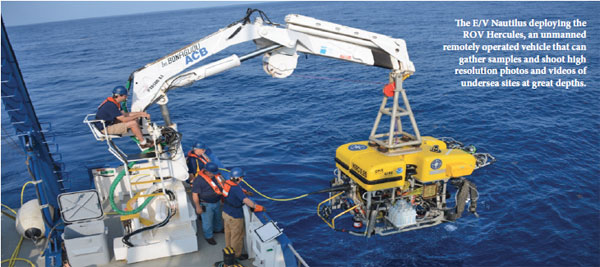 So far, T&T has no policies regulating deep sea marine life exploration and exploitation. And T&T also has no specific Marine Protected Areas to conserve any special sites of unique life, whether in shallow seas or deep ocean areas. This means that almost as fast as we discover new life and marine habitats, they are at risk of being destroyed by future mining or industrial operations. So far, T&T has no policies regulating deep sea marine life exploration and exploitation. And T&T also has no specific Marine Protected Areas to conserve any special sites of unique life, whether in shallow seas or deep ocean areas. This means that almost as fast as we discover new life and marine habitats, they are at risk of being destroyed by future mining or industrial operations.
“We in T&T have to wake up and face the reality – and start paying attention to deep sea areas,” believes Dr. Gobin – not only for reasons of conservation of marine biodiversity, but also to plan for wise, sustainable management of our known and unknown marine resources.
“I attended meetings on Areas Beyond National Jurisdiction (ABNJ), and at an international level, many countries are vying to come into the deep sea to explore and mine phosphates, metallic nodules, gold and other minerals. That is already happening globally. We are only just beginning to understand what we have in our nearby deep sea areas, but we need to know more. Once we get beyond our EEZ, that becomes open territory. We should be doing our own research and building our own knowledge base of these areas, in order to manage them.
“We would like to work with industry and corporate T&T to develop policies to sustainably manage deep sea areas, as well as continue the scientific research. It’s about balancing priorities – because the sea provides so much more than just minerals. The ocean is a carbon trap and helps regulate climate change. And there are marine genetic resources present. Many of our marine species are already being used in laboratories to create pharmaceuticals; for example some cancer drugs have come from marine products. There’s so much more to learn, and do. The deep sea is a huge resource that we really need to better understand.”
Dr. Gobin is working on a public outreach project, a partnership with NIHERST and The UWI, to produce a five-part educational series (DVD) about Trinidad’s deep sea biology, using some E/V Nautilus footage. Called “Deep Sea Wonders of the Caribbean,” the German Embassy and Shell are the two main funders of the project. By early 2018, the documentary will be available at educational institutions, with an eventual free online link for public access.
Dr Gobin’s varied interests, spirit of collaboration and innate sense of balance keep her a very motivated, passionate woman scientist who seems to have mastered the secret art of successful multi-tasking. She affirms: “Even after 35 years, to this day I absolutely love what I do!”
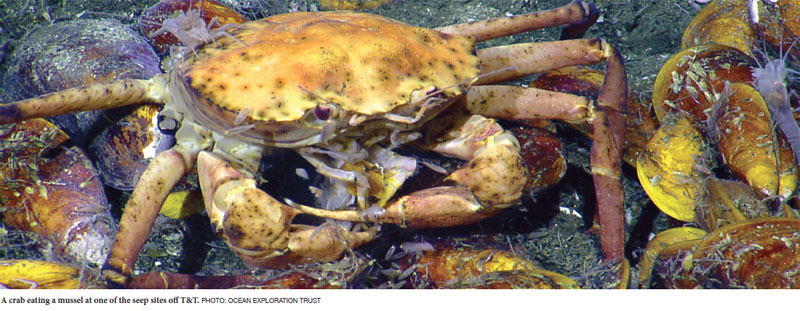
What are cold seeps?
The bottom of the ocean is a very, very dark place – although it’s possible for very slight sunlight to reach 1,000 metres deep under ideal conditions, that is rare, and from around 200 metres (or 656 feet) down, there is usually no light. Before the age of deep-sea exploration, human scientists believed there could be no life at all in deep sea beds in the absence of energy from the sun.
But life, as we now know, always seems to find a way, even in the harshest of environments. And on deep-sea beds, which are often like vast underwater deserts, life can thrive in rare pockets, feeding on the most curious of things, including streams of bubbling methane hissed out by the earth itself. Instead of photosynthesis, life here depends on chemosynthesis.
The ocean bed surrounding Trinidad has several methane gas vents or cold seeps, a feature of its ancient geological formation which has also gifted it with oil and gas deposits. Methane vents are deep-sea areas loaded with energy-rich chemicals. They are sites where fluids rich in hydrogen sulfide and methane leak from the seafloor.
The methane in cold seeps provides the energy to sustain unique communities of life which have evolved startling adaptations and symbiotic relationships to eat and to survive.
Links
About Prof Robert Ballard
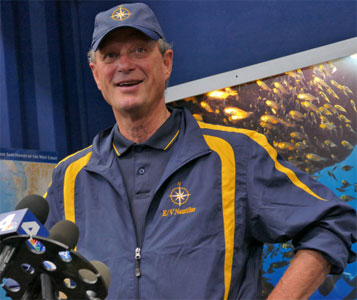 “I grew up wanting to be Captain Nemo from 20,000 Leagues Under the Sea”, said Prof Robert Ballard, the Kansas-born boy who moved to California. An ocean explorer, discoverer and historian, Prof Ballard is a scientist and retired US Navy officer. He is professor of oceanography at the University of Rhode Island. He is perhaps most famous for his underwater archaeology – he discovered the wreck of the RMS Titanic in 1985, among other significant shipwrecks such as the German battleship Bismarck and the lost fleet of Guadalcanal. “I grew up wanting to be Captain Nemo from 20,000 Leagues Under the Sea”, said Prof Robert Ballard, the Kansas-born boy who moved to California. An ocean explorer, discoverer and historian, Prof Ballard is a scientist and retired US Navy officer. He is professor of oceanography at the University of Rhode Island. He is perhaps most famous for his underwater archaeology – he discovered the wreck of the RMS Titanic in 1985, among other significant shipwrecks such as the German battleship Bismarck and the lost fleet of Guadalcanal.
Prof Ballard is an expert in marine geology and geophysics. He founded the Centre for Ocean Exploration and Archaeological Oceanography in 2003 as a graduate research programme at the University of Rhode Island. His most important scientific discoveries are of hydrothermal vents and “black smokers” in the Galapagos Rift and East Pacific Rise in 1977 and 1979 along with their exotic life forms living off the energy of the Earth through chemosynthesis.
Prof Ballard spent 30 years at Woods Hole Oceanographic Institution, where he helped develop telecommunications technology to create “tele-presence” for his JASON Project, which allows hundreds of thousands of schoolchildren to accompany him from afar on undersea explorations around the globe each year.
Dr Ballard founded the Ocean Exploration Trust in 2008 to explore unknown parts of the ocean, seeking out new discoveries in the fields of geology, biology, maritime history, archaeology, and chemistry aboard the 64-metre research ship, the E/V Nautilus. (Source: http://www.oceanexplorationtrust.org)
Shereen Ali is a writer and editor. |





